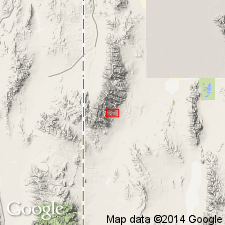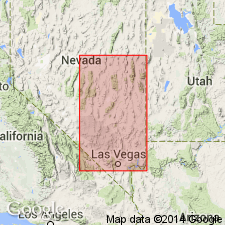
- Usage in publication:
-
- Shingle Creek Conglomeratic Quartzite
- Modifications:
-
- Named
- Dominant lithology:
-
- Quartzite
- AAPG geologic province:
-
- Great Basin region
Summary:
Pg. 296, 298-299 (pl. 1), 300-301. Shingle Creek Conglomeratic Quartzite. Name proposed for 1 of 6 formations of the McCoy Creek Group (new); mapped in central and north-central part of range. Is a massive cliff-forming unit about 500 feet thick. Bedding generally distinct but locally poorly defined; cross-bedding relatively rare. Quartzites are gray and brownish gray in medium and moderately dark and more rarely in light shades; range from coarse- to fine-grained. Contains gritty and conglomeratic lenses with well-rounded to subrounded pebbles of mostly quartz, but some red jasper. Overlies Strawberry Creek Formation (new) of McCoy Creek Group; underlies Osceola Argillite (new) of McCoy Creek Group. Drewes (1958, GSA Bull., v. 69, no. 2) mapped about 200 feet of quartzite as lowest exposed part of Prospect Mountain Quartzite, below an unnamed slate member; latter is Osceola Argillite and underlying quartzite is Shingle Creek Conglomeratic Quartzite, according to classification herein proposed. Age is late Precambrian. Report includes geologic map.
Named from Shingle Creek in the southern Snake Range, White Pine Co., NV (Great Basin region).
Type locality: north of Strawberry Peak. Well exposed in upper Willard Creek-Strawberry Pass area and in Shingle Creek where base is not exposed, northern part of southern Snake Range.
Source: US geologic names lexicon (USGS Bull. 1350, p. 690); GNU records (USGS DDS-6; Denver GNULEX).

- Usage in publication:
-
- Shingle Creek Conglomeratic Quartzite*
- Modifications:
-
- Age modified
- AAPG geologic province:
-
- Great Basin province
Summary:
Age of the Shingle Creek Conglomeratic Quartzite is Precambrian Z.
Source: GNU records (USGS DDS-6; Menlo GNULEX).
For more information, please contact Nancy Stamm, Geologic Names Committee Secretary.
Asterisk (*) indicates published by U.S. Geological Survey authors.
"No current usage" (†) implies that a name has been abandoned or has fallen into disuse. Former usage and, if known, replacement name given in parentheses ( ).
Slash (/) indicates name conflicts with nomenclatural guidelines (CSN, 1933; ACSN, 1961, 1970; NACSN, 1983, 2005, 2021). May be explained within brackets ([ ]).

